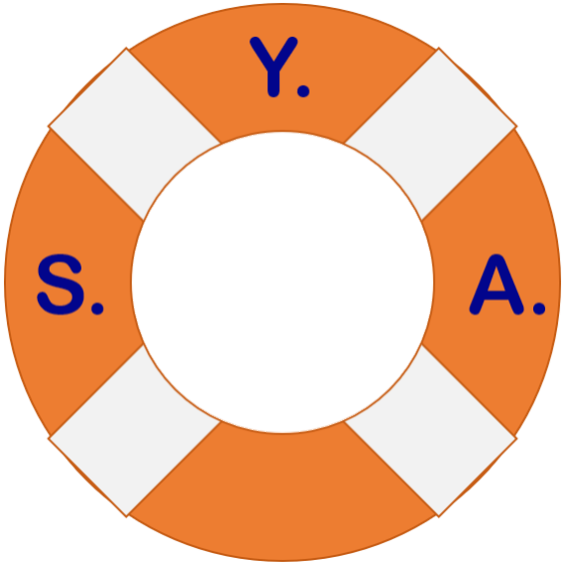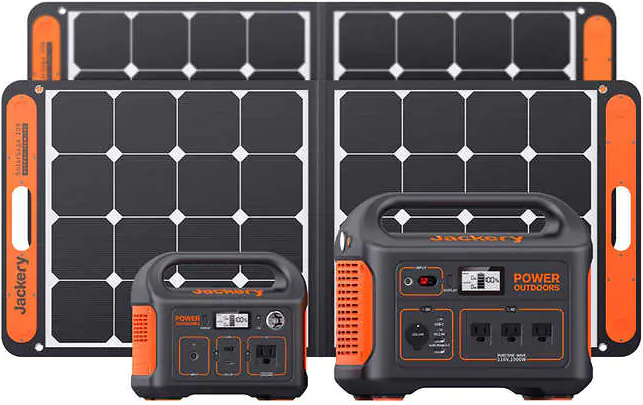This month I am going review my Jackery Solar Generator package that I bought through Costco in March. Back in April I wrote an article about the need for these battery backup solutions. From charging your phone or laptop to keeping larger appliances running during a power outage or disaster. If you missed it, you can read it here.
How did I choose a Jackery Solar Generator?
I had been looking at getting a battery station ever since the pandemic after buying a chest freezer to stock up on frozen meat. You can read that article here. I wanted something that could handle the chest freezer and my refrigerator during a power outage, especially in summer.
Jackery vs. Goal Zero
Initially, I had been looking at a Goal Zero product but then discovered the Jackery brand. I researched the specifications, prices, capabilities and customer reviews of products from both companies. It is easy to tell the two companies’ batteries apart: Goal Zero is lime green/silver/black and Jackery is orange/grey.
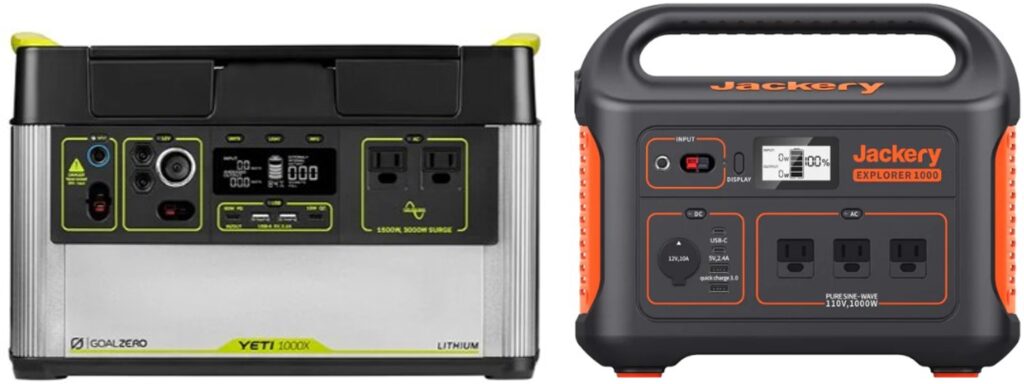
The capabilities of both products are very similar, however, Goal Zero has been in the process of updating their battery stations from using AGM lead-acid batteries to lithium-ion batteries. That made it more confusing to decide what to choose since there were two product lines to decide between and there were significant price differences between the batteries of similar wattage.
Jackery was already using lithium-ion batteries in its products. Their batteries were also less expensive than the Goal Zero counterparts. Overall, Goal Zero has a much larger product catalog with some nice backup solutions and outdoor accessories, if you can find anything in stock. Ultimately, customer reviews and pricing is what really steered me towards Jackery.
In the end, I chose a Jackery brand package that was a limited-time offer through Costco. It was an amazing deal when compared to the retail prices on the Jackery website or Amazon. I essentially paid for the two battery stations and got the two solar panels for free. I saved between $500-600 compared to buying them through Jackery or on Amazon.
About Jackery
For whatever reason, all Jackery batteries are called Explorer (number), however, they chose to badge the batteries either “Jackery Explorer (number)” or “POWER OUTDOORS”. For example, the Jackery Explorer 1000 specifications are identical to the Jackery Explorer 880.
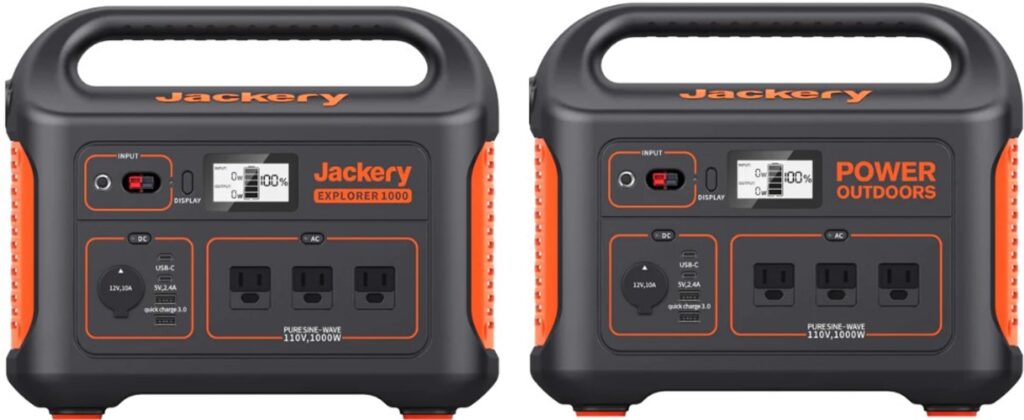
What is the difference between the product lines? There are only three batteries with the ‘Power Outdoors’ badging vs. six of the ‘Explorer’ badged batteries. The Explorer batteries all have a number that more closely matches their wattage. The Power Outdoors ones just seem to have been made up as they are nowhere near the wattage capabilities of the battery. Clear as mud? Here is a chart showing the badging so you can see what I’m talking about:
| Jackery Explorer | Power Outdoors |
| 1500 – $1699 | – |
| 1000 – $1099 | 880 – $899 |
| 500 – $529 | 550 – $549 |
| 300 – $299 | – |
| 240 – $219 | 290 – $249 |
| 160 – $140 | – |
Naturally, I was just as confused at first when I saw the deal at Costco so I quickly compared the specifications of the 880 vs. 1000 and the 290 vs. 240 to discover the specifications were identical.
According to Jackery’s website: “The Jackery Explorer 880 is an official product of Jackery specially supplied for offline sales channels like The Home Depot, Lowe’s, Harbor Freight Tools, etc.” Apparently Costco is one of those channels as well, with my products carrying the POWER OUTDOORS badging. A quick check showed that all stores carried options under both badging.
I’m not sure if Jackery will continue the “offline channel” POWER OUTDOORS badging or are moving exclusively to the EXPLORER (number) badging. It would definitely simplify their product portfolio and end some unnecessary confusion.
My Needs
First and foremost, I got this Jackery Solar Generator package as part of my emergency preparedness kit. As you will see below in my testing, I wanted to be able to keep my refrigerator and chest freezer running during a power outage so my food didn’t spoil. I also wanted to be able to keep my Internet router connected, be able to turn on a light at night, run a small fan or watch the TV (I have an HD antenna which picks up quite a few channels).
I’m also an avid outdoorsman, which includes drive-in camping and extended road-trips. It’s nice to be able to power or recharge electrical devices on the go without having to search for an outlet.
My Setup
My Jackery Solar Generator package consists of two battery stations and two solar panels plus their charging adapters:
Jackery Explorer 880
(Explorer 1000 spec equivalent)

Jackery Explorer 290
(Explorer 240 spec equivalent)

A/C Adapters
Each battery station comes with a wall charging adapter that looks like a laptop computer brick and a 12v adapter to charge from your vehicle. The provided storage case is padded and keeps everything easily accessible while making it easy to pack or stash somewhere so it’s out of the way when not in use.
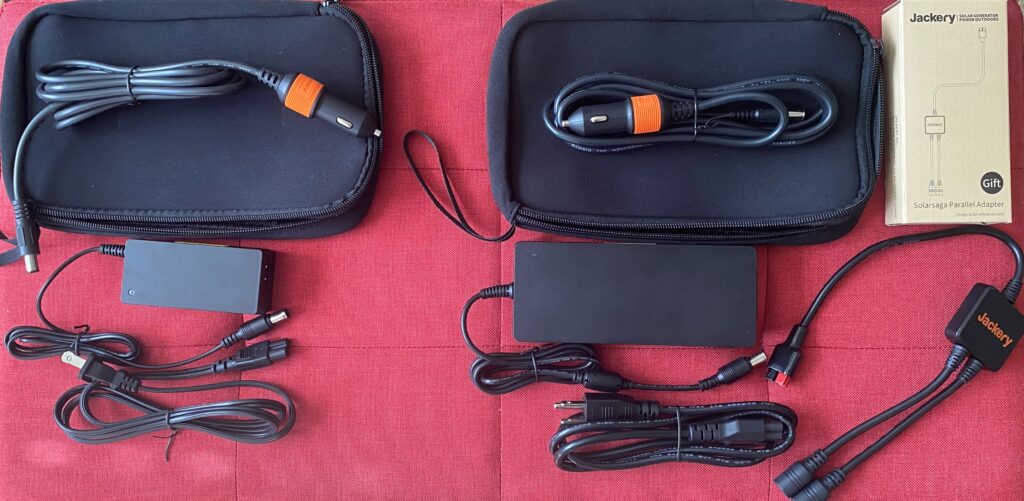
As you can see in the picture, the power bricks are proportionate in size to the battery station they charge. I also got an adapter to connect both solar panels to the larger battery station at the same time allowing it to recharge faster (theoretically – more on that below). The smaller battery station can only use one solar panel.
2 – 100w Solar Saga portable solar panels

Each solar panel has a 10ft charging cable so you can have your battery in the shade away from the elements while charging it. As a bonus, each panel has two USB ports for charging devices directly: A USB-A and a USB-C.
All this is stored in a zippered pouch on the back of each panel when not in use.
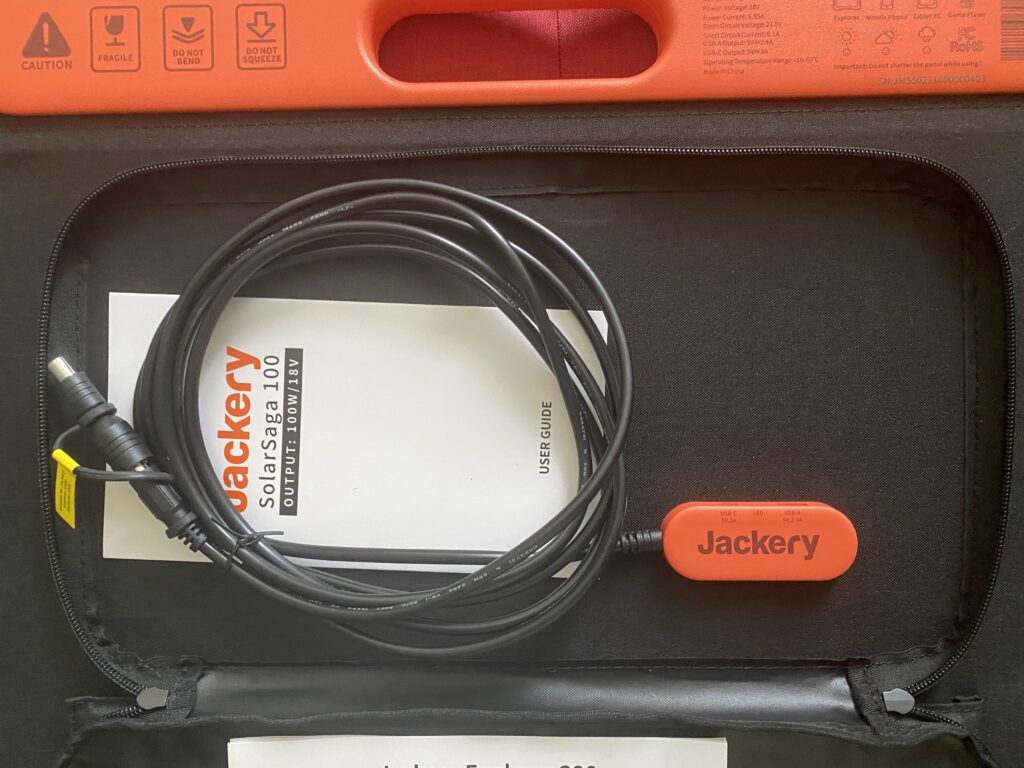

Real-world Test – Part 1
To get an idea of real-world results, I decided to run my refrigerator/freezer and chest freezer on these battery stations. I wanted to know before I lost power how long I could realistically run each appliance to keep my food from spoiling. My hope is that I can get through the night with the batteries. Then I can recharge them during the day from the solar panels as long as the sun is out.
One of the big selling points for this system was that I can charge the batteries while using them, just like a laptop.
Spring (March 12) 3-hour test
I plugged the refrigerator/freezer into the 1000w battery and the chest freezer into the 200w battery. I noted the temperatures and wattage draw on each at the time.
Temperatures:
- Outside Temp: 53F
- Inside Temp: 68F
- Garage Temp: 58-60F
Wattage drain according to the station display:
- Refrigerator (Explorer 880: 1000w pure sine-wave battery)
- Idle: 1-16w
- Normal Running: 105-123w
- Runtime: 10% battery drain over 3 hours
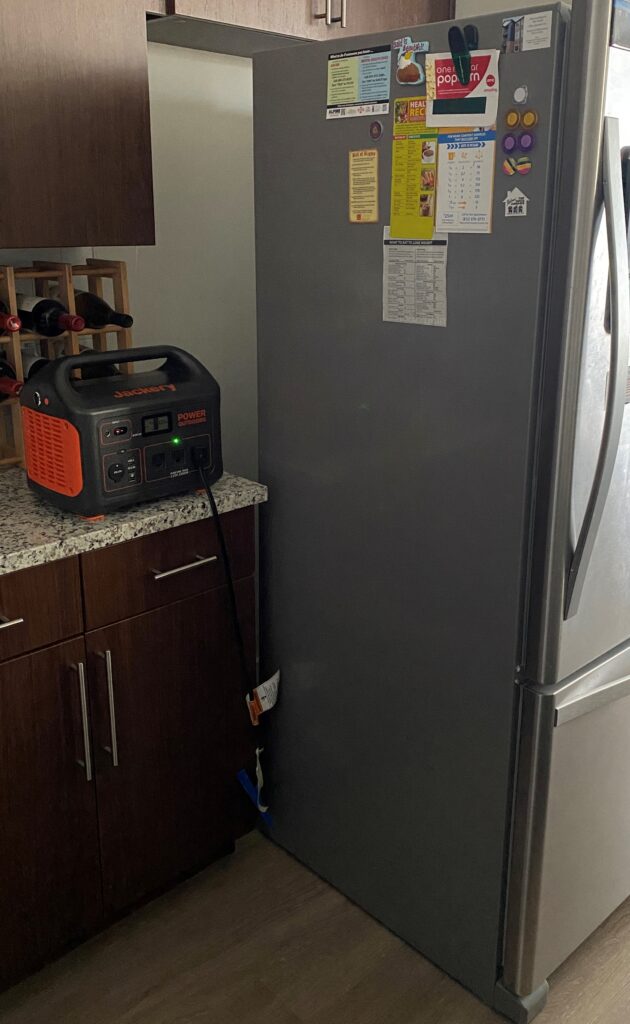
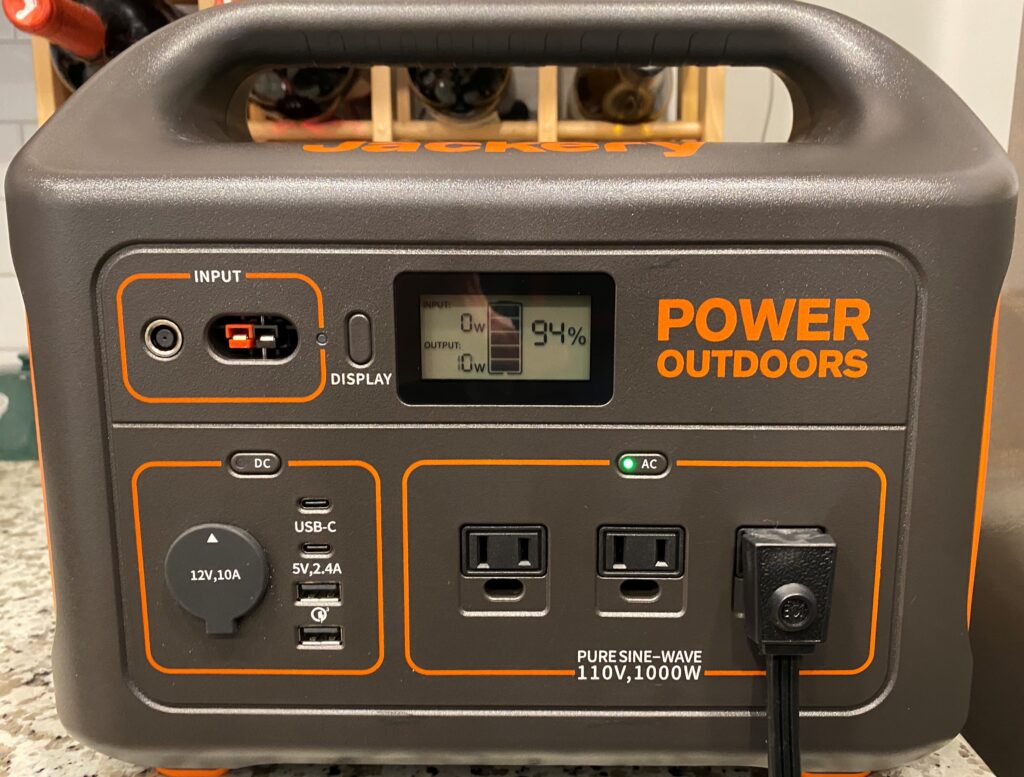
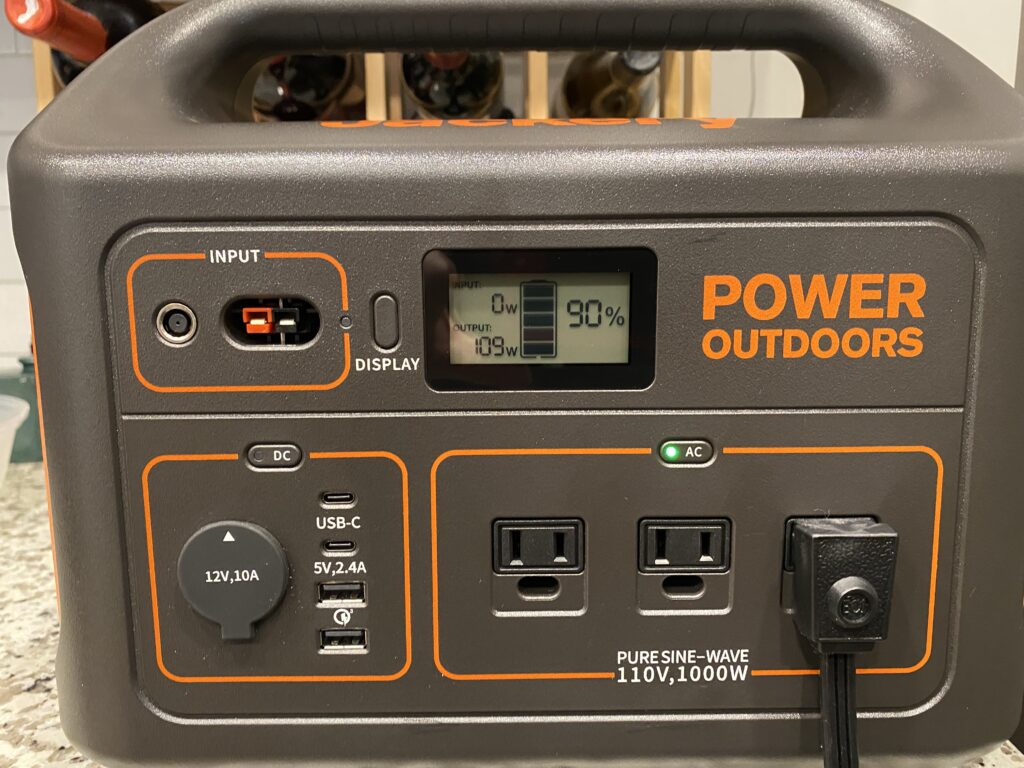
- Chest Freezer (Explorer 290: 200w pure sine-wave battery)
- Idle: 1-4w
- Running: 62-135w
- Runtime: 12% battery drain over 3.0 hours
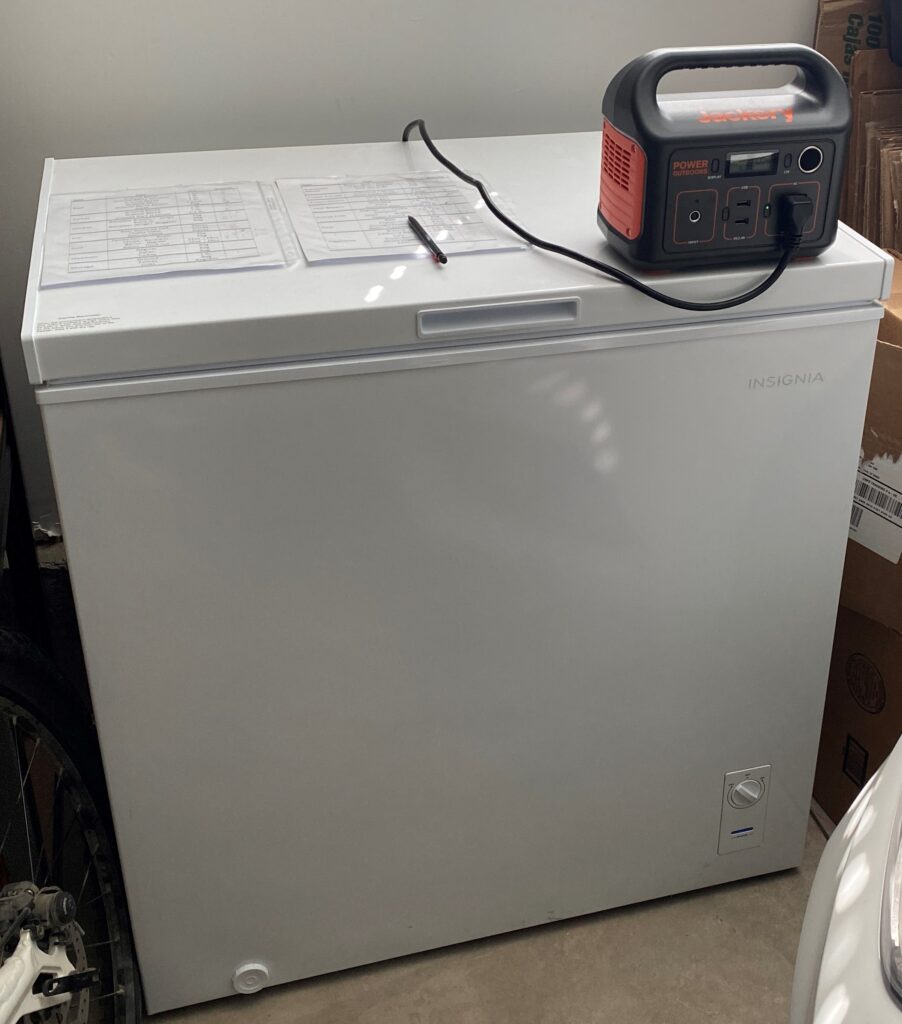
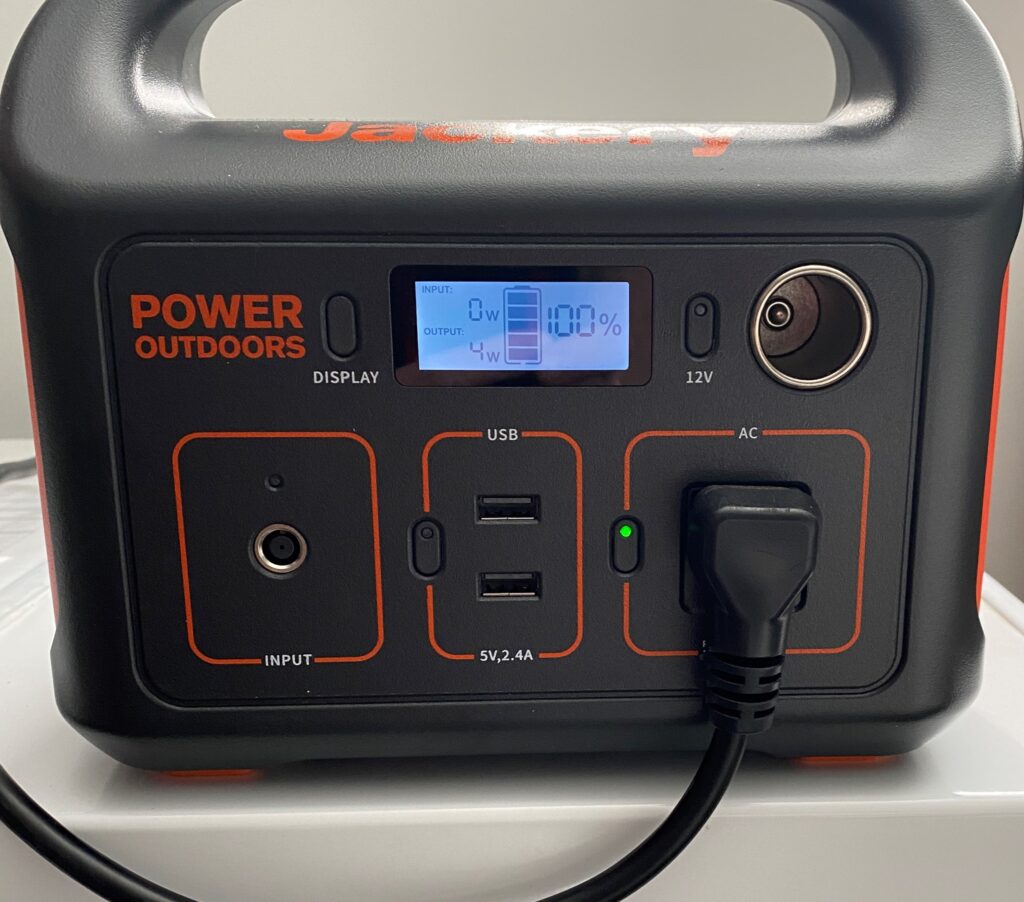
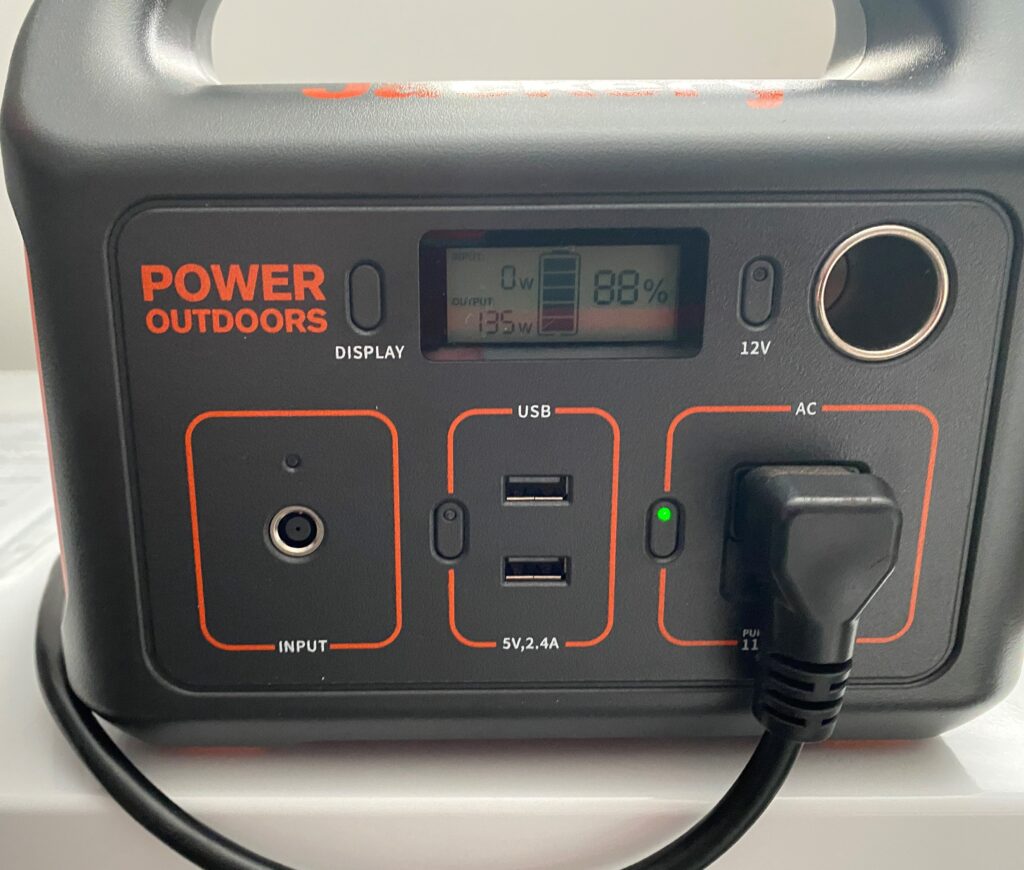
Built-in surge protector
Technically the 290 battery should have been able to handle my chest freezer, however, a couple times during the test the load surge of the compressor kicking in for the chest freezer exceeded the Explorer 290’s surge limit (400w). Fortunately, the built in surge protector kicked in and shut off power to the plug port as designed to protect the battery station.
Explorer 290 getting new duties
After having to turn power back on several times I realized this would not be a good solution during an actual outage. I switched to the Explorer 880 battery after the refrigerator test was complete. It had no problems running either appliance. It should easily suffice to keep both appliances working during a power outage. With the ability to recharge both stations from the solar panels, it is theoretically possible to keep both running for the duration of a multi-day power outage.
With the 290 out for the chest freezer, I moved it to my laptop and got the following results.
- 15″ Laptop (Explorer 290: 200w pure sine-wave battery)
- On but Idle: 15-21w
- Active Use: 30-50w
- Runtime: 7% battery drain in 1 hour of active use
- Off but charging the battery: 18-24w
During a power outage I decided I would most likely use the 290 to keep my Internet router working. It draws even less electricity than the laptop so it should be able to keep my Internet and Wifi connected as long as my Internet service provider is still available.
Real-world Test – Part 2
Since it is early spring, the temperatures have not reached their summer peaks. That is when both the house and garage would be warmer making the appliances run more often to keep their contents cold/frozen.
I will run the test again in July. I expect to see the batteries drain quicker compared to the spring since the appliances will run more often to maintain their temperatures. Once I have that data I can determine if I have sufficient capacity to keep everything running during a multi-day outage.
Summer (July 21) 3-hour test
And just like that 4 months have passed. This time I plugged both the chest freezer and refrigerator into the battery at the same time to simulate a real-world scenario.
The battery is in the garage in the shade where it is in reach of the cables for the solar panels out on my driveway. I used outdoor rated light-duty (16 gauge) extension cords to plug the appliances into the battery. The surge wattage is when I initially plugged both appliances in and lasted about 10-15 seconds before dropping to normal levels.
Temperatures:
- Outside Temp: 92-97F
- Inside Temp: 77F
- Garage Temp: 83-86F
Wattage drain according to the station display:
- Refrigerator & Chest Freezer at the same time (Explorer 880: 1000w pure sine-wave battery)
- Surge wattage – Refrigerator: 832 for ~15 seconds
- Surge wattage – Chest Freezer: 513 for ~15 seconds
- Idle: 16-20w
- Normal Running: 77-187w
- Runtime: 10% battery drain over 1 hour
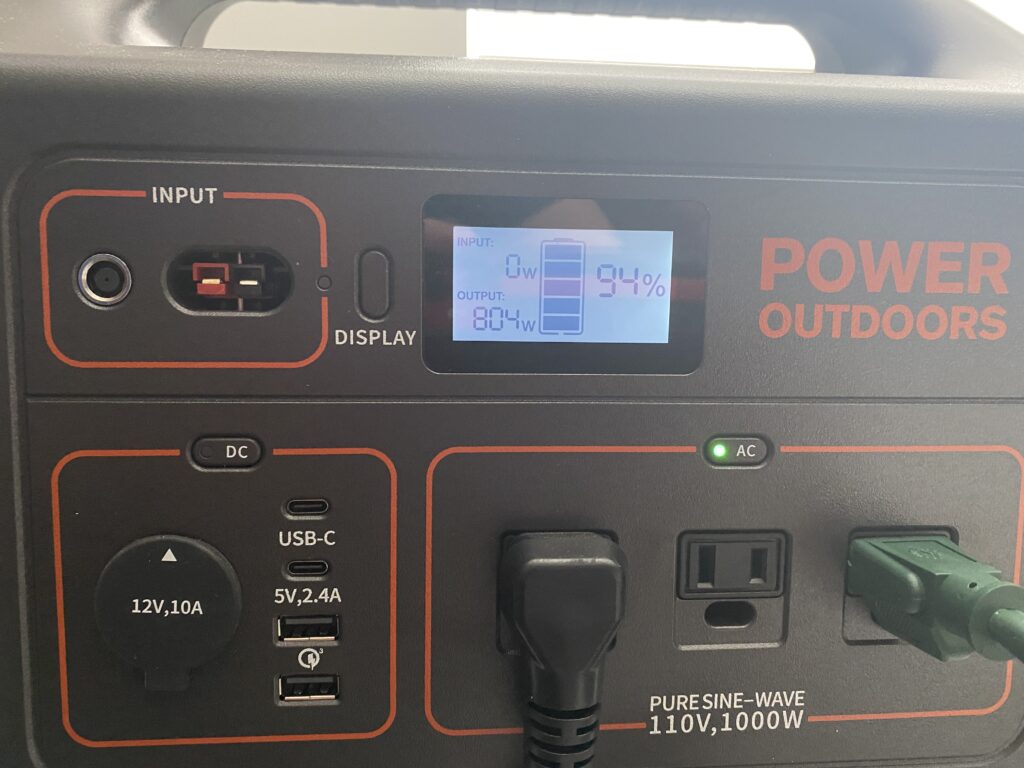
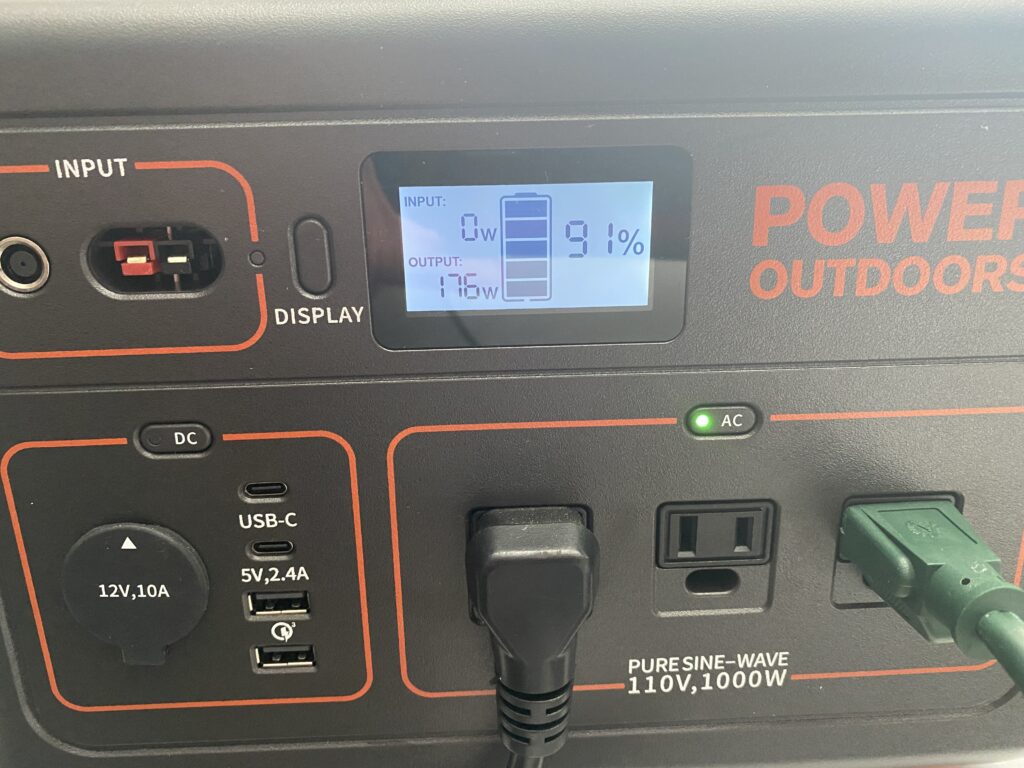
Based on these numbers, I could theoretically run both appliances for 9-10 hours before needing to charge the battery which is more than enough time to get through the night and plug the solar panels in the next day to recharge.
Since it is typically cooler at night and with no one opening either appliance, they should need to run less often than during the day. Even if the battery were fully drained by morning, as long as it hasn’t been more than 4 hours without power, the food should not spoil. The key would be getting the solar panels charging the battery as soon as possible.
Recharging with the Solar Panels
This was the main reason I went with a battery generator solution. The ability to recharge the battery using solar panels instead of needing fuel for a conventional generator. It’s safer, quieter and cleaner than a gas or diesel fueled one. As long as the sun is out I can recharge my batteries at no additional cost.
Based on the position of the sun with regards to my house I will have to move the location of the solar panels in the morning until the driveway is in the sunlight. That also means moving the battery to be within reach of the panels’ 10ft cable.
Jackery does sell a 16.4 ft extension cable for the solar panels but at $39 per cable, it is a bit steep. The only benefit is being able to place your battery farther (26ft) from where the panels are setup. Placing my battery within 10ft of the panels works for me. l have both a 50 ft extension cord (only cost $16) and 100 ft extension cord which is overkill in terms of the distances between my appliances and where I can place the battery.
Jackery’s documentation indicates that I should be able to fully charge the 880 battery with 2 solar panels in 6.5 hours. That is based on optimal positioning of the panels in relation to the sun. In reality, it’s more like 7-8 hours.
Built-in kickstand
While the built-in kick-stand is handy for setting up the panels, it definitely is not the optimal angle depending on the time of year and the sun’s position in the sky. You may actually get better input with the panels lying flat on the ground facing up in the middle of the day with the sun directly overhead. The kick-stand is best during the morning and evening hours when the sun’s position can make better use of the angle the panels sit at. Otherwise you might want to use something else to prop the panels at an angle that gets you the most input wattage.
Here are some pictures of charging the batteries from the solar panels:
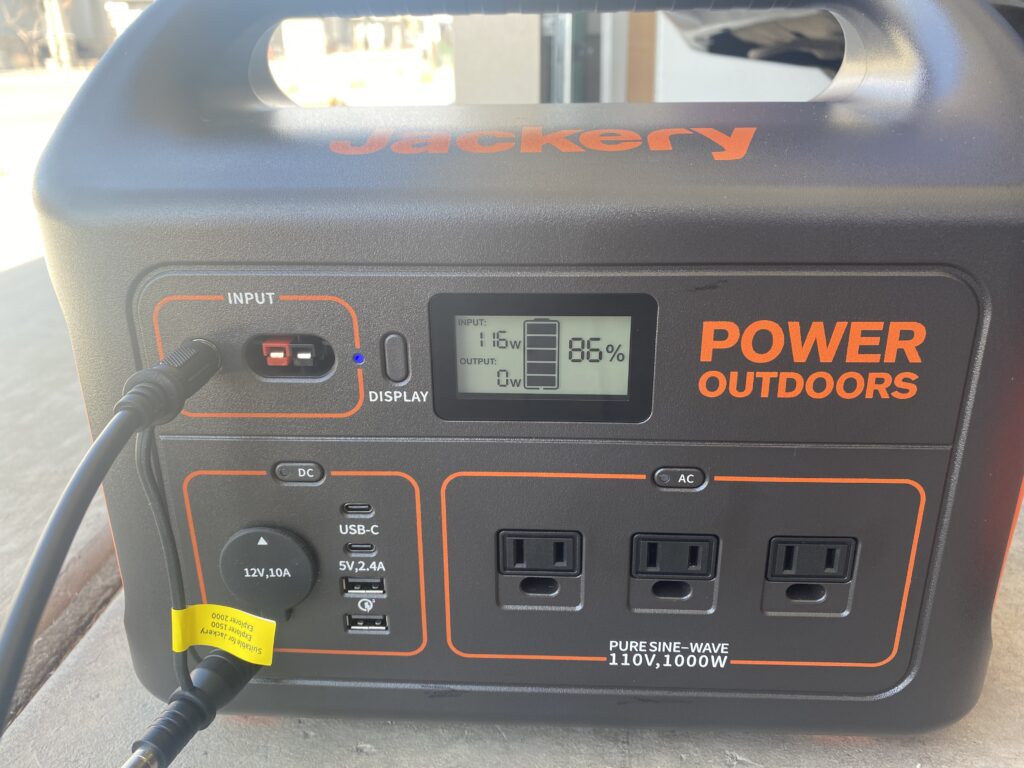
Explorer 880 w/ 1 solar panel – 116w although a few minutes earlier I got as high as 128w.
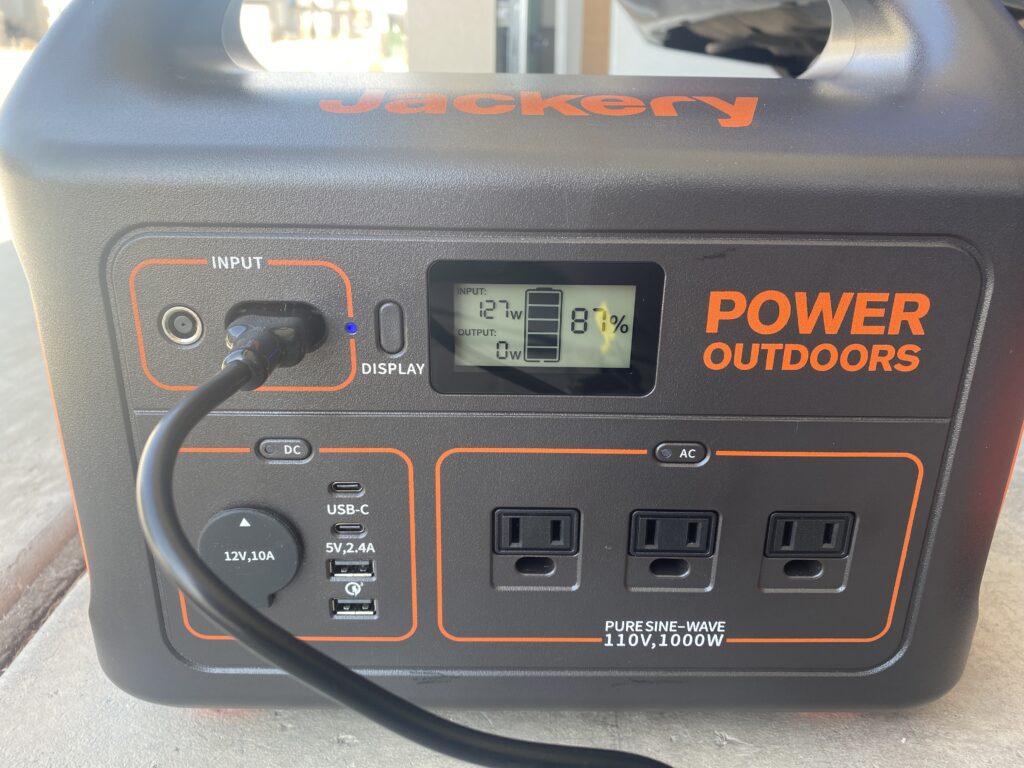
Explorer 880 w/ 2 solar panels – only 11w more than 1 panel. The most I saw using both was 135w.
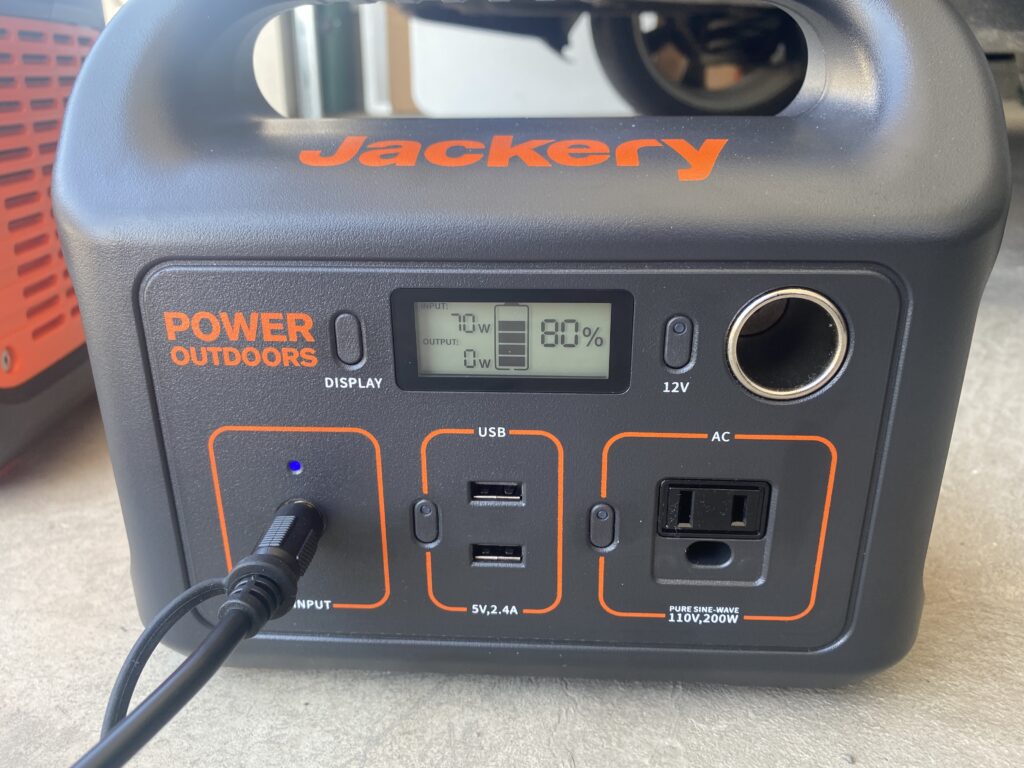
Explorer 290 – 70w. It can only use a single panel. The most I got was 75w.
In reality it means continually adjusting the panels as the sun moves to get as much input as possible. You will never manually be able to get optimal positioning so just accept that and move on. Expect to need at least 8 hours to fully recharge, especially if you are using the battery at the same time you are charging it from the solar panels.
Daylight hours
Here in Utah, I have 10-12 hours of direct sunlight during summer months which should be more than enough time to ensure the battery is fully charged each day.
During the winter, it is between 7-9 hours, but it is cold enough that the appliances shouldn’t run as often as summer. I’m confident I could recharge whatever the battery uses overnight easily even with the reduced daylight in winter.
With my July test numbers having both appliances plugged in at the same time, if only one appliance is actively cooling the input wattage of the solar panels should exceed the drain on the battery thereby allowing the battery to increase its overall charge. Only when both appliances are actively cooling at the same time would there by a slight reduction in the battery charge.
My only concern
I am disappointed about one thing with the solar panels. I fully bought into the marketing claims and expected having two 100 watt solar panels would charge the 880 much faster than one. In my testing, each panel could individually provide between 105-128w of input to the 880.
When combined using the included parallel Anderson Input connector I expected much closer to 200w of input, but I was limited to 127-135w. I would have been happy with 175-180w of input, but my tests only provided ~11w more input. Based on that I see no benefit to having two panels over a single panel to charge the 880.
Two panels are still better than one
Having two panels is still better than one, though, since one could get broken or stop working. I can also use one panel to charge each batter simultaneously. When the smaller battery is fully charged, I can move the panel to the larger battery in dual mode, even if it only gives me ~11w more input.
That said, 11w more input is 11w less drain on the battery thereby letting it last longer each day. Since I essentially got the 2 panels for free based on my package cost, I can live with that. If I had purchased the two panels at retail price I would be less than thrilled with this discovery.
Verdict
POSITIVE:
- Small
- Lightweight
- Quiet
- Portable
- Green – uses renewable energy
- Safer – No fuel needed
- Non-polluting
- Great for emergencies and outdoor activities
NEGATIVE:
- Price per watt higher than a gas generator
- Portable ones not big enough to run whole house
- Handles don’t fold down flat on the battery stations.
Overall, I am very happy with my Jackery Solar Generator package. I got an extremely good deal which helps offset the solar panel shortcoming I mentioned above. It will still meet the needs I purchased it for when the situation arises providing me peace of mind. It also works great for outdoor activities like camping and being off-grid for several days.
I would recommend the Jackery brand to anyone looking for a battery backup solution for camping, off-grid activities or part of your emergency preparedness plans.
Last Updated on August 25, 2022
